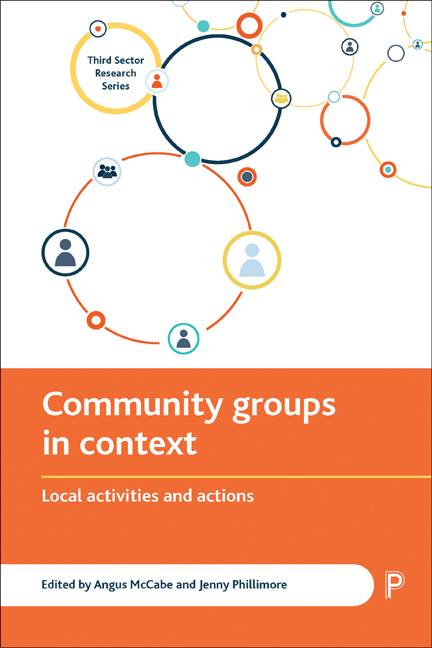Book contents
- Frontmatter
- Contents
- List of tables and figures
- Foreword
- Series editor’s foreword
- Acknowledgements
- Notes on contributors
- Introduction Why get below the radar? The importance of understanding community groups and activities
- Part One Scoping and mapping community actions and activities
- Part Two Community groups and activities in context
- Part Three Under-explored radars
- Part Four Thinking about voice, learning and emotion below the radar
- Index
six - All change? Surviving below the radar: community groups and activities in hard times
Published online by Cambridge University Press: 05 April 2022
- Frontmatter
- Contents
- List of tables and figures
- Foreword
- Series editor’s foreword
- Acknowledgements
- Notes on contributors
- Introduction Why get below the radar? The importance of understanding community groups and activities
- Part One Scoping and mapping community actions and activities
- Part Two Community groups and activities in context
- Part Three Under-explored radars
- Part Four Thinking about voice, learning and emotion below the radar
- Index
Summary
Chapter aims
Whereas Chapter Four reflected on key changes in policy towards communities and community groups, this chapter, which draws on 85 interviews and six focus groups conducted in 2010, 2012 and 2015, asks the following questions:
• How have these groups responded to change over the past six years?
• What was the impact of policy shifts and, in particular, what was the effect of central and local government budget cuts below the radar?
• What are the challenges for both communities and government itself in delivering the agendas of localism, ‘social action’ and open public services?
Introduction
Participants in the research that informs this chapter were recruited at a number of levels, and comprise representatives from national community network organisations and from regional and local infrastructure agencies, staff in small community-based voluntary organisations, and unpaid activists in volunteer-led organisations. Care was taken to involve a wide range of groups and perspectives, those active in communities of interest as well as at a neighbourhood level, ‘single-cause’ groups, such as black and minority ethnic (BME) and women's organisations, and advocacy organisations as well as service providers.
Resource constraints meant that interviews were undertaken in three regions in England – West Midlands (35), London and the South East (30) and the North West (20) – rather than offering national coverage. The relative decline in the number of organisations involved between 2010 and 2015 reflects a wider trend of groups either closing or lacking the capacity to participate (for example, because of losing paid workers and being staffed only by volunteers).
At each stage of the research, reference groups consisting of practitioners, policymakers, activists and academics reviewed the findings to reflect on their accuracy in terms of lived experience below the radar and their applicability. All those organisations and individuals involved have been anonymised to comply with ethical requirements.
Background: austerity in policy context
For all the talk of ‘community engagement’ over the past decade or so, in practice, it has tended to mean little more than consultation with the community. The term ‘community’ has tended to be adopted in an uncritical fashion and assumed to relate to a coherent set of individuals or groups who share common goals, interests or geographies. Community activists in the study who had previous experience of Area Based Initiatives reported that far too often ‘engagement’ has felt like a tick-box exercise, a gesture towards dialogue rather than a genuine attempt to listen and change.
- Type
- Chapter
- Information
- Community Groups in ContextLocal Activities and Actions, pp. 113 - 132Publisher: Bristol University PressPrint publication year: 2017

